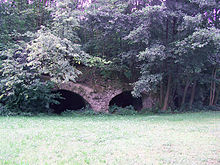Burgwallbach
Burgwallbach is a district of the municipality of Schönau an der Brend and is located in the heart of the salt forest, a forest area in the Bavarian Rhön Nature Park , 336 m above sea level.
history
The remaining ruins are remnants of the small moated castle, Burg Wallbach . There used to be a small lake around the castle (field name: Alter See )
At the beginning of the 14th century, the knight brothers Heinrich and Margold Marschalk were the first known owners of Burg and Gut Wallpach. They came from the family of the Marschalk von Ostheim . Their liege lords were the Counts of Henneberg, who in turn are subject to the Prince-Bishops of Würzburg .
Wallpach Castle was first mentioned in 1335 .
Prince-Bishop Albert II von Hohenlohe (1345–1371) besieged the castle in 1357 and destroyed it because the Marschalks had given his enemies shelter. In the same year he signed a security contract with the Marschalks, lent them the castle again and allowed it to be rebuilt.
The Marschalks von Wallpach took part in the crusades in 1489 and then settled in Tyrol. In that year Bernhard, Marschalk von Wallpach, sold the castle and all associated property to his brother-in-law, Baron Anton von Bibra , for 1,172 guilders.
Emperor Friedrich III. awarded in the following year Blutbann, Halsgericht, stick and gallows in Oberwalbach and Niederwalbach to Wilhelm von Bibra and his brother Anton. At that time Wilhelm was envoy to the Pope in Rome. Innocent VIII awarded him a letter of indulgence for the newly built church in 1498 . Pope Alexander VI renewed this indulgence letter and sent relics of the holy martyrs Eugenius , Felix and Urban I. for the church of Niederwallbach.
With all other goods belonging to Hans von Bibra, the castle and the Niederwallbach district (on the S-curve) with the church were also destroyed in 1525 during the Peasants' War.
Heinrich von Bibra, the last of the Burgwallbach line, built the current church in 1571 and 1572.
After Heinrich von Bibra's death, Prince-Bishop Julius demanded the fiefdom be returned in 1602 because the line of the barons of Bibra zu Irmelshausen with inheritance rights was Protestant. Bernhard von Bibra therefore led a lengthy process against the bishops of Würzburg. ( Thirty Years War ) Finally, in 1681, the verdict was passed. In a settlement, Burgwallbach was left to the prince-bishops. As compensation, the Bibras received the Brennhausen estate in Grabfeld.
In 1790 the castle was finally destroyed, released for demolition and used as a quarry.
On January 1, 1978, the previously independent municipality of Burgwallbach was incorporated into the neighboring municipality of Schönau an der Brend .
Individual evidence
- ^ Federal Statistical Office (ed.): Historical municipality directory for the Federal Republic of Germany. Name, border and key number changes in municipalities, counties and administrative districts from May 27, 1970 to December 31, 1982 . W. Kohlhammer GmbH, Stuttgart and Mainz 1983, ISBN 3-17-003263-1 , p. 741 .
Web links
- Reconstruction drawing in the medieval state by Wolfgang Braun
Coordinates: 50 ° 21 ′ 29 ″ N , 10 ° 6 ′ 35 ″ E

